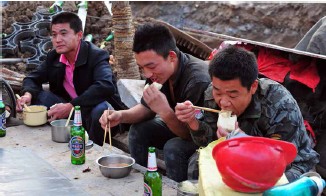The rapid growth of sales of premium beer and equally rapid decline of the cheap one cannot be explained only by consumers’ preferences change. The answer to the question “What is going on?” can be found in the publication by The Boston Consulting Group on FMCG Chinese market.

Despite the well-publicized slowdown in economic growth, overall consumer sentiment in China can still be described as cautiously optimistic. More precisely, caution characterizes the lower end of the consumer market, while optimism envelops the high end.
 China, in other words, has become a two-speed consumer market. The optimistic, “high-speed” consumer market* disproportionately consists of middle- to upper-middle-class and affluent households. As ranks of high-speed consumers swell and their incomes rise, these households will likely be responsible for nearly …% of the increase in consumption during period 2015-2020. By the way, these consumers also make up the bulk of the digital class of active online shoppers we have written about above.
China, in other words, has become a two-speed consumer market. The optimistic, “high-speed” consumer market* disproportionately consists of middle- to upper-middle-class and affluent households. As ranks of high-speed consumers swell and their incomes rise, these households will likely be responsible for nearly …% of the increase in consumption during period 2015-2020. By the way, these consumers also make up the bulk of the digital class of active online shoppers we have written about above.
*Specifically, this consumer market consists of upper-middle-class and affluent households in tier 1, tier 2, and tier 3 cities, whose monthly income exceeds RMB 12,000 or $1,900, and middle-class, upper-middle-class, and affluent households in tier 4, tier 5, and tier 6 cities, whose monthly income exceeds RMB 8,000 or $1,300.
Although the survey was conducted before the collapse of the market, its findings are still broadly relevant. It found that consumer sentiment was nearly the same among households that held stocks and those that did not. In any case, only … percent of Chinese households invest in the market.
Let us pay attention to conclusion by BCG research. Companies reducing the production also cut down spending on salaries for a big number of direct workers, and resultantly, sales of cheap beer and instant noodles fell dramatically as they are traditionally bought by “blue colors”. According to the company’s estimation, in 2015, sales of instant noodles dropped by …%.
This makes the link of beer consumption and per capita GDP alternations clear. Yet, there remains a question, why the official income dynamics is still rather stable?
One of the reasons is the presence in the country of a huge social class, inner migrants, who have a big consumption potential. They are major consumers of inexpensive beer which has been sold ever worth over the recent years.
The “black box” of the Chinese market
“A huge social class” was not just a figure of speech but an acknowledged fact. In China there are 274 mln of migrant workers, former country dwellers who move to a city by their own or sometimes with their families in order to find a job.
The inner migration makes up 19.4% of all China’s population or 28.6% of its active age population (from 16 to 65). That is, nearly a fourth of the Chinese providing for their families have to earn for their living outside their homes.
The social integration of migrants into the urban environment is limited to Hukou (urban registration system). By rigorous record-keeping of the population in urban and rural areas Hukou does not permit moving to cities for resident living. As a result, about 40% of megacities’ population accrues to “unofficial” dwellers. And Hukou significantly limit migrants’ rights, leaving them without the social welfare, education, and public services that city dwellers have.
Thus, the inner migrants compose the most mobile category of the labor force whose employment is not much limited by the social responsibility of employers and determined by the social situation at the market.
On the one hand, we see the data on migrants’ number and the average salaries, published by NBSC. On the other hand, the real earnings of such a numerous category of workers are not possible to accurately account in the official statistics.
The point is, of 274 mln migrants only 23.1% take part in the pension insurance system, that is, officially employed. The rest 76.9% of migrants do hard work and get small salaries without properly established social guarantees and contracts.
 As we know, fast growth of beer consumption in the country can be achieved minimum under two conditions – a low basic level of consumption and rapid growth of population’s income. Likewise in China, the social “black box” of the consumption market which includes most of migrants, played a big role in the beer market growth.
As we know, fast growth of beer consumption in the country can be achieved minimum under two conditions – a low basic level of consumption and rapid growth of population’s income. Likewise in China, the social “black box” of the consumption market which includes most of migrants, played a big role in the beer market growth.
To better understand the significance of migrants, let us in the first place consider the connection between the income levels and beer consumption. In order to do it we will try to depict a typical migrant. Let us call him the most common name in China, Wang Yong.
Firstly note that Wang Yong is a man of 18-30. That is the age group that drinks the most. Wang Yong came from a village where he is likely to have family members, he has to provide for. At the average a migrant’s households consists of 2.86 persons, 1.49 of who works.
Over the last decade Wang Yong’s income has grown very much which allows him buying ever more goods beside the basic ones. According to the statistics, the monthly income of a migrant worker in 2014 amounted to 2 864 yuan. For comparison, in 2011 this figure was 2 049 yuan, and 1 340 yuan in 2008.

NBSC reports contain data which give an idea on how much different goods consumption depends on household’s income level. Under our estimation*, per capita income level Wang Yong’s household belongs to «low income» group. As for this group beer is one of the few affordable luxuries, in case of a …% income growth in the household, Wang Yong is likely to drink …% more beer.
* Basing on the official migrants’ salary level and the average share of the working households’ members.
In other words, it is the group where migrants belong, that most dynamically influenced the beer consumption according to people’s well-being.
Yet, Wang Yong’s work is lowly–paid, that is why he is very sensitive to his income change. Besides, the social vulnerability makes him save up to …% of his income (Wang Yong is growing ever more rational with age).
It may seem not quite correct to associate migrants with households, at least because many of migrants do not live with their families or have not yet started a family of their own. But as numerous researches evidence, such life only raises probability to become an alcohol consumer and correlates with consumption level growth as spouses generally are listed as the most influential social control agent.
There were also special surveys on alcohol consumption among working migrants. They confirm that Wang Yong has nothing against drinking sometimes. According to a research* made in Fudan University in Shanghai, the percentage of drinkers among male migrants of different age is approximately the same, that is, …% or more than half of respondents consume alcohol.
* Alcohol consumption analysis among migrant workers in Shanghai [J] Fudan University Journal of Medical Science, 2015, 42 (01): 18-23.
 Normally there is no public catering for workers from rural areas. So, Wang Yong eats mostly porridge, noodles, and semi-finished products at home or at cheap diners, often washing it down with beer. This is the main and most affordable kind of alcohol that can be drunk even at a dinner.
Normally there is no public catering for workers from rural areas. So, Wang Yong eats mostly porridge, noodles, and semi-finished products at home or at cheap diners, often washing it down with beer. This is the main and most affordable kind of alcohol that can be drunk even at a dinner.
Thus, according to the research data, …% of drinking migrants indulged themselves with a beer at least once a month, …% consumed spirits and …% bought low-alcohol beverages.
If Wang Yong belonged to the small group of migrants that earn well (more than … yuan), the probability of alcohol consumption would be twice higher than for the poor migrant earning less than … yuan.
Why is Wang Yong drinking less beer?
How has the ‘new normal’, slower growth pattern of China’s economy actually influenced Wang Yong’s income?
It goes without saying, that due to gender specifity, the profession affects the level of alcohol consumption. According to the surveys, among migrants the most of drinkers are employed in construction, industry of entertainment and production.
 Let us consider the structure of the work migrants’ allotment by branches in 2015. Basing by the statistics data, Wang Yong is probably a man with junior middle school education and he works as a builder or a factory worker.
Let us consider the structure of the work migrants’ allotment by branches in 2015. Basing by the statistics data, Wang Yong is probably a man with junior middle school education and he works as a builder or a factory worker.
Thus, the sector of processing industry and construction employs 56.6% of 274 mln migrants. In other official publications quoted 22% of the total migrants’ number to be employed in the construction, and three builders out of four are inner migrants.
But the construction turned out to be the most vulnerable to the structural problems of the Chinese economy. During the dynamic economy growth, a huge number of the common Chinese made their contribution in the heating of country’s housing markets. When it cooled off, both share-buyers and building companies incurred losses.
In 2015, the investment growth into house building decreased by five times to 2.9%. The construction area shrank by 16%. It stands to reason, the decline in number and size of constructions leads to fewer jobs, which in the first place will affect those who work without a contract. Besides, the Ministry of Construction of China pointed to salary arrears to work migrants.
Such situation affected the beer consumption. Wang Yong has become more rational in his spending.
Yet, builders are not the only group, whose well-being came at risk. Weak global demand continued to weigh on exports in China.
For the whole year of 2015, exports fell 1.8% year-over-year to 14.14 trillion yuan. And the statistics for 1H2016 look not better – exports fell 2.3% year-over-year to 6.39 trillion yuan. Despite yuan devaluation foreign demand for Chinese industry production is falling.
China’s steel industry, which accounts for more than half of global production, contracted for the first time in almost 35 years in 2015. The companies of the China Iron and Steel Association incurred losses to the sum of 64.5 bln yuan, though 2014 gave them 22.6 bln profit.
If Wang Yong worked in coal or steel industry, his salary could not only fall due to the decline in production China’s steel production dropped by 4%, while the European Union saw a 6.3% drop. Our migrant even risks being laid off like 15% (1.8 mln people) of other workers of these branches who were sacked as part of efforts to reduce industrial overcapacity.
 As we have already discussed, the possibility of losing a job induces consumer’s economizing on alcohol. In such conditions beer is out of question.
As we have already discussed, the possibility of losing a job induces consumer’s economizing on alcohol. In such conditions beer is out of question.
Certainly, here we considered the pressure points of the Chinese economy and a specific social group, migrants. The service sphere and the economy rebalancing on the inner consumption are rather effective in compensating the negative trends and keeping the GDP growth. But we can see that lower income level of migrants could have become the key reason for beer sales drop due to the reduction of a major economy segment of the market.
To get the full article “Analysis of beer market in China” in pdf (60 pages, 65 diagrams) propose you to buy it ($45) or visit the subscription page.
2Checkout.com Inc. (Ohio, USA) is a payment facilitator for goods and services provided by Pivnoe Delo.




